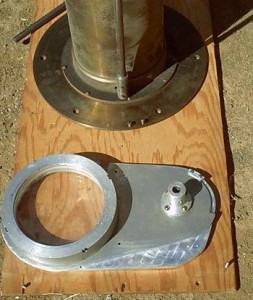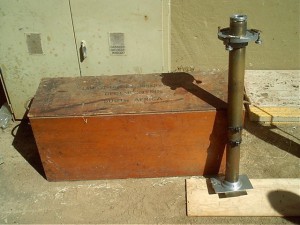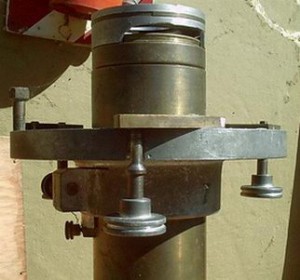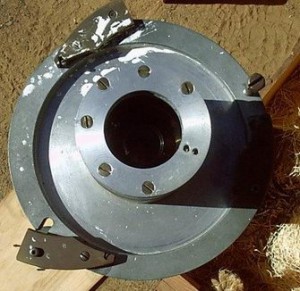|
Index: |
|
|
|
|
IntroductionThe Bloemfontein Branch of ASSA has an historical workgroup, which is very active. They research the histories of Boyden and Lamont-Hussey Observatories and also try to find original material. One of the methods is to identify possible missing components and then during lectures the public is asked to look out for the components. A few very interesting finds have been made in the past. On one occasion the tube of the 27-inch telescope with its mounting were identified and moved to a “safe haven”, the Ehrlicpark (Mangaung) fire station which has a Fire Station Museum. It can now be called a fire station and astronomy museum. In another find some telescope components were identified, including a Warner and Swasey clock drive. Follow up research by Dr. Patrick Seitzer (a very active collaborator of the historical group and astronomer at the University of Michigan, USA) showed this to be possibly the clock drive of a 6-inch Clark refractor, which is missing. [Penning; MNASSA April 2004.] For more information see Look and Found. Braam van Zyl, member of the Bloemfontein Astronomy Society is also a fireman. He has managed to persuade his superiors to establish a museum for the fire prevention industry. In one of the mysteries of life, as luck would have it, the tube of the 27-inch telescope was discovered next to the building which now housing the Fire Station Museum. Since he is also involved with the historical workgroup, it became logical to move the telescope tube into the building, and so the Museum dedicated to the fire prevention industry acquired an astronomical flavour as well. Since then, more objects have been found, and it was logical to also add them to the Museum. That is why we now have astronomical objects in the Fire Station Museum. |
|
|
|
Link to the Main Bibliography Section and more information about Sources. |
|
|
Gallery

The Ehrligh Park (Mangaung) Fire Station Museum Hanger where the Astronomy museum also resides.
Photo Credit: Friends of Boyden (Gerrit Penning)
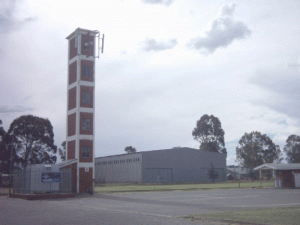
A Northwest view of the Fire Station Museum, showing the tower and hangar.
Photo Credit: Friends of Boyden. (Gerrit Penning)
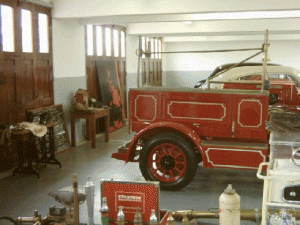 Part of the Fire Prevention Display.
Part of the Fire Prevention Display.
Photo Credit: Friends of Boyden. (Gerrit Penning)
Lamont_Hussey 27-inch telescope
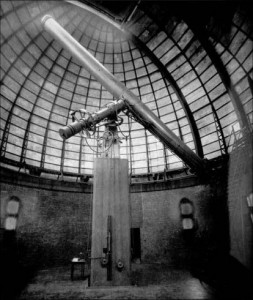
Early photo of the 27 inch Jena Telescope mounted at Lamont-Hussey Observatory.
Source: A.S.S.A. Symposium 2002: Paper 05 Penning: The Lamont-Hussey Observatory 1927- 1974
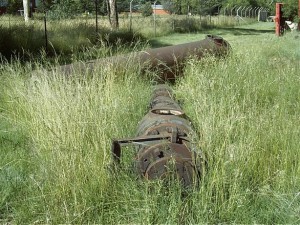 Part of the 27-inch telescope found in a field alongside an aircraft hangar at a fire brigade station in Bloemfontein. (The hanger now houses the Ehrlichpark (Mangaung) Fire Station Museum. The counterweight assembly in the foreground with the lower part of the telescope tube in the background.
Part of the 27-inch telescope found in a field alongside an aircraft hangar at a fire brigade station in Bloemfontein. (The hanger now houses the Ehrlichpark (Mangaung) Fire Station Museum. The counterweight assembly in the foreground with the lower part of the telescope tube in the background.
Source: A.S.S.A. Symposium 2002: Paper 05 Penning:The Lamont-Hussey Observatory 1927- 1974
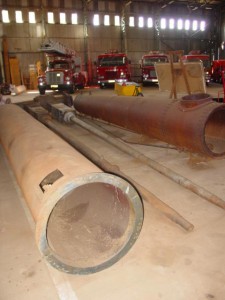
The Tube moved inside the building.
Source: Friends of Boyden.

Mounting for the 27 inch telescope.
Source: A.S.S.A. Symposium 2002: Paper 05 Penning: The Lamont-Hussey Observatory 1927- 1974.


In 1924 a completed 27 inch lens was delivered to Hussey in Ann Arbor, through the optics firm McDowell in Pennsylvania. The lens and other optics are now at the University of Michigan , U.S.A.
Source: A.S.S.A. Symposium 2002: Paper 05 Penning: The Lamont-Hussey Observatory 1927- 1974
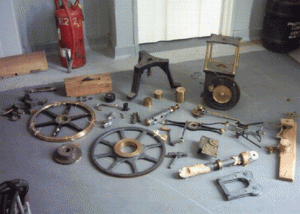
Components of the Lamont Hussey 27-inch telescope.
Source: Friends of Boyden.
Mars cameras
Introduction:
-In 1956 Mars was at a very favourable closest approach to Earth. The International Mars Committee established at Lowell Observatory decided observe the event at Lamont-Hussey observatory as Mars is always better to observe in the south at time of closest approach. Earl Slipher came out to South Africa with two camera’s specially made to photograph Mars. The one camera was longer than than the other. “In our observations two seperate cameras were employed, one adjusted for blue photographs and magnifying about 200 times, and the other arranged for yellow orange ad red photographs magnifying about 260 times”
-Some of the best ever photographs of Mars before the age of satellites were taken with these two camera’s. The telescope used was the 27 inch telescope
-After the closest approach the cameras were supposed to have been sent back to Lowell Observatory in U.S.A. For an unknown reason they were not returned but put into storage at the graveyard section of the Bloemfontein Municipality. In 1999 the “Parks Boards” heard about the cameras and thought them to be telescopes. They were taken to a viewpoint to be erected as public telescopes. The project wasn’t successful and this time the cameras were placed in storage behind the elephant cages at the local zoo. Here the astronomy society called “The Friends of Boyden” traced the cameras. [See Lost and Found]
-Note: MNASSA gives date of Mars perihelion as 1954 and Sky and telescope as 1956.
Sources:
-Personal communication with Braam van Zyl of the “Friends of Boyden” [CdC]
-Dobbins, T.A. and Sheenan W.; Mars Mania 1956; Sky and Telescope, June 2003.
-Mars fever at Bloemfontein-1954, MNASSA, Vol. 62; nos7&8, pp.190-191.



